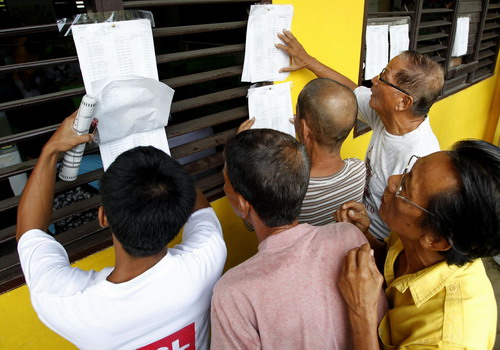Asia-Pacific
Voting for Philippine general election begins
(Xinhua)
Updated: 2010-05-10 09:38
 |
Large Medium Small |
MANILA - Voting of the Philippine presidential and local elections began at 36,679 polling stations at 7 am Monday.
At the hometown of presidential candidate Benigno Aquino III, almost 100 voters arrived at a polling station half an hour before the voting officially started.
"I will cast my vote to "Noynoy" Aquino," said a female voter.
|
||||
Polling stations are open from 7 am to 6 pm local time on Monday.
More than 50 million Filipinos have been registered as voters this year, of whom, 85 percent said they would vote, according to the Election Commission (Comelec).
The latest survey conducted by Social Weather Station on May 2 and May 3 showed Liberal Party candidate Benigno "Noynoy" Aquino III got a 42 percent preference rate, 22 percent ahead of former President Joseph Estrada, who got 20 percent.
A nother poll body Pulse Asia said four in every 10 Filipinos support Aquino III. His two major rivals Estrada and Manuel Villar Jr. had a supporting rate of 20 percent each.
Seven areas in the Philippines were placed on Saturday by the country's Commission on Elections (Comelec) under its control due to escalating elections-related violence there.
These areas are Nueva Ecija and Abra; Bequey in Cagayan; Davao City in Davao del Sur; Dasol in Pangasinan; Pantao, Ragat and Matungao in Lanao del Norte and the Autonomous Region in Muslim Mindanao, the Comelec said.
In a resolution, the Comelec said it saw the need to put those places under control because of threats, heightened political rivalries, electoral anomalies, presence of armed groups and history of election-related in these places.
The resolution said the move is to "ensure the conduct of free, peaceful orderly, honest and credible elections" in the areas.
To implement the resolution, the Comelec had ordered the creation of a special task force composed of the highest Comelec, police and military officials in the concerned areas.
In the Philippines, elections have always been haunted by violence. According to police statistics, 229 election-related violence incidents occurred during the congressional mid-term election in 2007, killing 121 people and injuring 176; 249 election-related violence incidents occurred in the 2004 General Elections, causing the death of 148 people and injuring 261 people.
Before the 2010 General Elections, election-related violence were still rampant, with the Maguindanao massacre, the worst ever in the Philippines, in which 57 people including media workers and pregnant women were slain, shocked the whole world.
Police figures released on April 26 showed that 27 people, including city councilors, village councilors, village leaders and common people, were killed and 37 people were injured from January 10, when election campaigns started, to April 25.










